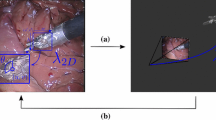Abstract
Objective
Use of the robotic assisted surgery has been increasing in recent years, due both the continuous increase in the number of applications and the clinical benefits that surgical robots can provide. Currently robotic assisted surgery relies on endoscopic video for navigation, providing only surface visualization, thus limiting subsurface vision. To be able to visualize and identify subsurface information, techniques in image-guidance can be used. As part of designing an image guidance system, all arms of the robot need to be co-localized in a common coordinate system.
Methods
In order to track multiple arms in a common coordinate space, intrinsic and extrinsic tracking methods can be used. First, the intrinsic tracking of the daVinci, specifically of the setup joints is analyzed. Because of the inadequacy of the setup joints for co-localization a hybrid tracking method is designed and implemented to mitigate the inaccuracy of the setup joints. Different both optical and magnetic tracking methods are examined for setup joint localization.
Results
The hybrid localization method improved the localization accuracy of the setup joints. The inter-arm accuracy in hybrid localization was improved to 3.02 mm. This inter-arm error value was shown to be further reduced when the arms are co-registered, thus reducing common error.
Similar content being viewed by others
References
Birkfellner W, Watzinger F, Wanschitz F, Enislidis G, Kollmann C, Rafolt D, Nowotny R (1998) Systematic distortions in magnetic position digitizers. Med Phys 25(11): 2242–2248
Denavit J, Hartenberg R (1955) A kinematic notation for lower-pair mechanisms based on matrices. Trans ASME J Appl Mech 23: 215–221
Diodato MSP, Klingensmith M, Damiano R (2004) Robotics in surgery. Curr Probl Surg 41(9): 752–810
Fitzpatrick JM, West JB (2001) The distribution of target registration error in rigid-body point-based registration. IEEE Trans Med Imaging 20(9): 917–927
Fitzpatrick JM, West JB, Maurer CRJ (1998) Predicting error in rigid-body point-based registration. IEEE Trans Med Imaging 17(5): 694–702
Frantz DD, Wiles AD, Leis SE, Kirsch SR (2003) Accuracy assessment protocols for electromagnetic tracking systems. Phys Med Biol 48(14): 2241–2251
Kapoor A, Taylor R (2008) A constrained optimization approach to virtual fixtures for multi-handed tasks. In: IEEE international conference on robotics and automation. ICRA 2008, pp 3401–3406. doi:10.1109/ROBOT.2008.4543730
Kim HL, Schulam P (2004) The paky, hermes, aesop, zeus, and da vinci robotic systems. Urol Clin North Am 31(4): 659–669
Kwartowitz D, Galloway R, Shiavi R (2009) Determining the presence of bias error using statistical methods. IEEE Trans Inf Technol Biomed 13(1): 1–4
Kwartowitz D, Herrell S, Galloway R (2007) Update: toward image-guided robotic surgery: determining the intrinsic accuracy of the davinci-s robot. Int J Comput Assist Radiol Surg 1(5): 301–304
Kwartowitz DM, Herrell SD, Galloway RL (2006) Toward image-guided robotic surgery: determining intrinsic accuracy of the da vinci robot. Int J Comput Assist Radiol Surg 1(3): 157–165
Lam JS, Bergman J, Breda A, Schulam PG (2008) Importance of surgical margins in the management of renal cell carcinoma. Nat Clin Pract Urol 5(6):308–317, 1743–4270. doi:10.1038/ncpuro1121
Rosen II, Lane RG, Kelsey CA (1979) Accuracy of a two-sensor sonic digitizer. Med Phys 6(6): 536–538. doi:10.1118/1.594618. URL: http://link.aip.org/link/?MPH/6/536/1
Stefansic JD, Bass WA, Hartmann SL, Beasley RA, Sinha TK, Cash DM, Herline AJ, Galloway RL (2002) Design and implementation of a pc-based image-guided surgical system. Comput Meth Prog Biomed 69(3): 211–224
Wagner A, Schicho K, Birkfellner W, Figl M, Seemann R, Konig F, Kainberger F, Ewers R (2002) Quantitative analysis of factors affecting intraoperative precision and stability of optoelectronic and electromagnetic tracking systems. Med Phys 29(5): 905–912
Wiles A, Thompson D, Frantz D (2004) Accuracy assessment and interpretation for optical tracking systems. In: SPIE: Medical Imaging. SPIE, San Diego
Author information
Authors and Affiliations
Corresponding author
Rights and permissions
About this article
Cite this article
Kwartowitz, D.M., Miga, M.I., Herrell, S.D. et al. Towards image guided robotic surgery: multi-arm tracking through hybrid localization. Int J CARS 4, 281–286 (2009). https://doi.org/10.1007/s11548-009-0294-1
Received:
Accepted:
Published:
Issue Date:
DOI: https://doi.org/10.1007/s11548-009-0294-1




